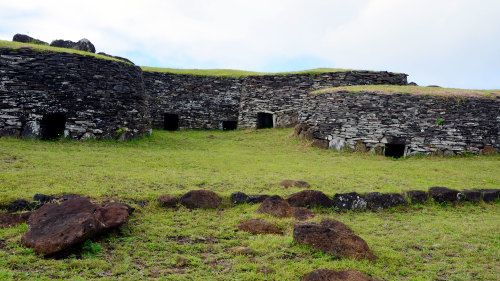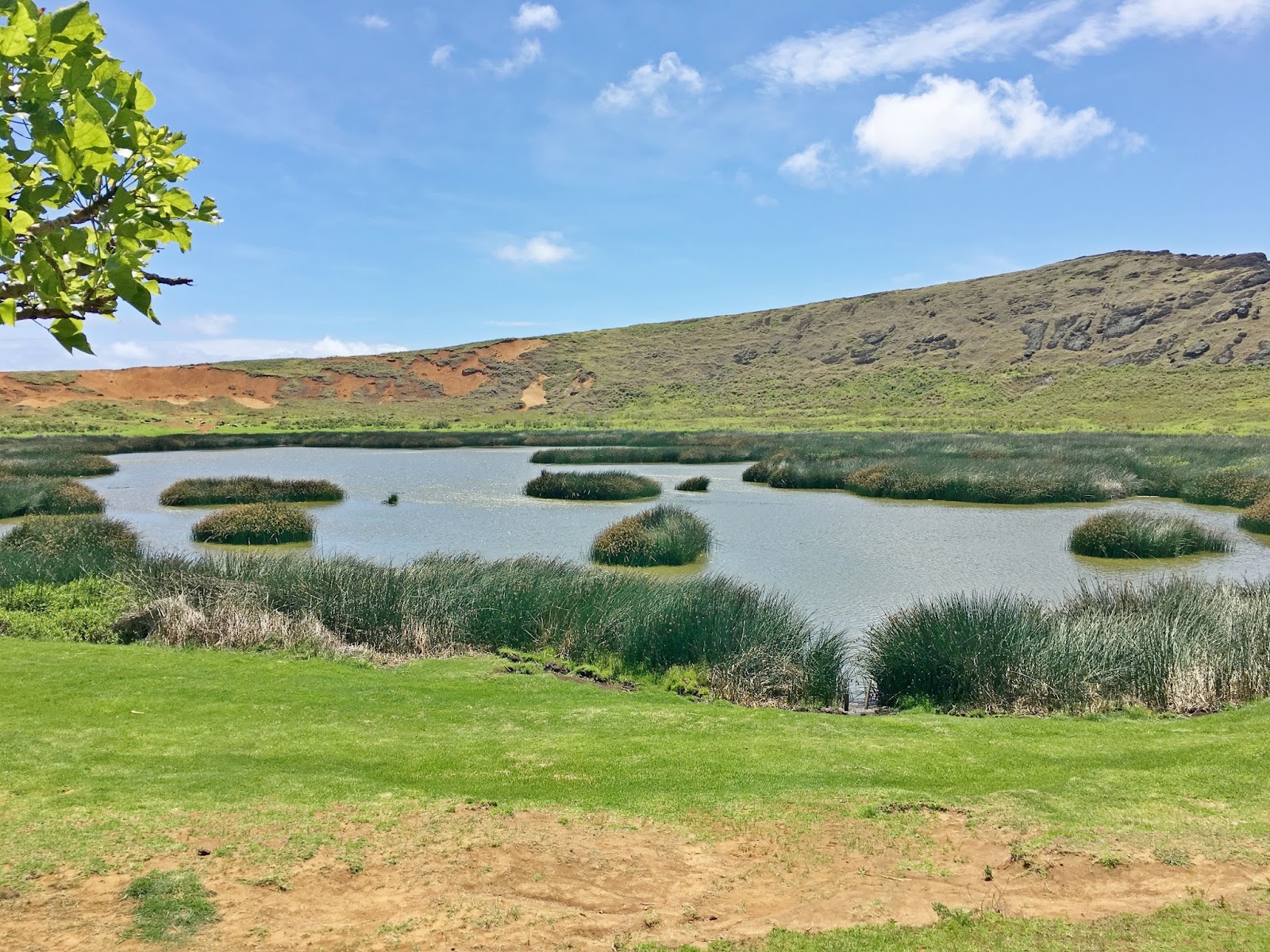--------------------------------------------------------------------------------------------------------------------------------------------------------------------------------------- 2017 CHILE: SANTIAGO, EASTER ISLAND & PATAGONIA
November 17 - 26, 2017
----------------------------------------------------------- ----------------------------------------------------------------------------------------------------------------------------
NOVEMBER 17 - 26
CHILE: SANTIAGO, EASTER ISLAND & PATAGONIA
CHILE FLAG
November 17
NEW YORK-LIMA-SANTIAGO
Flew Latham Air from JFK to Lima then to Santiago with Virgil, a friend from NY. Arrived at our hotel in Santiago and the location couldn’t be better. The view across from our room is the National Library and to the right is the beautiful Santa Lucia Hill and below is the swimming pool.
Time to explore the city.
Dinner at one of the restaurants in the city market building.
Walked around the Plaza de Armas on the way back to the hotel.
November 18
SANTIAGO
After breakfast we decided to check out the Santa Lucia Hill. It used to be a fort during the period of the Conquista but now it is a beautiful park towering over Santiago offering a panoramic view of the city.
More walking around the city and then a quick lunch followed by more walks around the city.
November 19
RAPA NUI (EASTER ISLAND)
Just arrived in Rapa Nui (Easter Island or Isla de Pascua), bought the $80 pass to see the National Park, met our hotel pick-up and checked in at Rapa Nui Orito cabañas. Surprised to see Mario, another friend from NYC at the airport.
Later went to Hanga Roa, the main town in Rapa Nui and looked at the moais along the beach and then had dinner at the Pea Restaurant. Dishes ordered were Ceviche, Shrimp Pil Pil, Fish of the day and Atun plus exotic drinks. Met another Filipino from California, Darwin, who is also on our scheduled tours for the next two days.
November 20
RANU KAO*ORONGO*TAHAI*VINAPU*AHU AKIVI*PUNA PAU
We were picked up by our tour guide to start our island tour and started at Ranu Kao, an extinct volcano. This is part of Rapa Nui National Park which is in its entirety a UNESCO World Heritage Site. It has a crater lake about a mile wide which is one of the island's only three natural bodies of fresh water.
Next stop is nearby Orongo, a ruined ceremonial village which is located at the point where the sea cliff and inner crater wall converge. It consists of low, sod-covered, windowless, round-walled buildings with even lower doors. Between the 18th and mid-19th centuries Orongo was the center of a birdman cult whose defining ritual was an annual race to bring the first manutara (sooty tern) egg back undamaged from the nearby islet of Motu Nui to Orongo. The site has numerous petroglyphs, mainly of tangata manu (birdmen) which may have been carved to commemorate some of the winners of this race.
Next we drove to the Tahai Ceremonial Complex, an archaeological site restored in 1974 by the late Dr. William Mulloy, an American archaeologist. It comprises three principal ahu: Ko Te Riku (with restored eyes), Tahai, and Vai Ure.
Lunch break at the Haka Honu restaurant in Hanga Roa.
Next part of the tour was Vinapu, another ceremonial center with a large ahu.
Next stop was Ahu a Kivi with the seven moais which represent the 7 explorers sent to the island before the arrival of the colonizers led by Hotu Matu’a. Ahu Akivi is a particular sacred place in Rapa Nui, looking out towards the Pacific Ocean. The site has seven moai, all of equal shape and size, and is also known as a celestial observatory that was set up around the 16th century. The site is located inland, rather than along the coast. Moai statues were considered by the early people of Rapa Nui as their ancestors or Tupuna that were believed to be the reincarnation of important kings or leaders of their clans and were erected to protect and bring prosperity to their clan and village. A particular feature of the statues is that they exactly face sunset during the Spring Equinox and have their backs to the sunrise during the Autumn Equinox.
We next visited Puna Pau, a quarry in a small crater or cinder cone on the outskirts of Hanga Roa. It was the sole source of the red scoria that the Rapa Nui people used to carve the pukao (topknots) that they put on the heads of some of their iconic moai statues and also used for some petroglyphs.
Cocktails and dinner at La Kaleta in Hanga Roa with Virgil, Mario and our new friend from California, Darwin who is on his way to Antartica. Nice drinks (Pisco Sours and Pina Coladas) and seafood (ceviche, shrimp salad, grilled fish), beautiful sunset.
November 21
AHU AKAHANGA, RANO RARAKU, TONGARIKI, TE PITO KURA
First this morning is Ahu Akahanga, a ceremonial platform also known as “the king’s platform”, because it’s said that the first king of the island, the Ariki Hotu Matu’a, could be buried here. Legend has it that the king left his home in Anakena after a fight with his wife, Vaka A Heva, and lived out his days here.
Here, like in other ceremonial platforms of the island, the moai were toppled by their own creators. The most accepted theory is that they are toppled face down so that the face, especially the eyes, was buried in the earth. However, in Ahu Akahanga’s case, apparently there was a sort of domino effect, whereby the larger moais on the right fell backwards.
To the right of the square there is a small cave, whose entrance was handmade and may have offered shelter. Behind the platform, there are also several crematoriums.
Next we drove to Rano Raraku, a volcanic crater formed of consolidated volcanic ash. It was a quarry for about 500 years until the early eighteenth century, and supplied the stone from which about 95% of the island's known monolithic sculptures (moai) were carved. On the outside of the quarry are a number of moai, some of which are partially buried to their shoulders in the spoil from the quarry. They are distinctive in that their eyes were not hollowed out, they do not have pukao and they were not cast down in the island's civil wars. For this last reason, they supplied some of the most famous images of the island. We even hiked up to the crater which has fresh water.

RAPA NUI*SANTIAGO
Today we fly back to Santiago and there was a surprise in the plane - a native dancer!
November 23
SANTIAGO*PUERTO NATALES
Flew out of Santiago to Punta Arenas then took a three hour bus ride from the the airport to Puerto Natales. Checked in at Pire Mapu Cottage B&B then walked around town, lunch at Kawesqar Cafe, dessert and hot chocolate at Cafe Angelica, back at the hotel for some chilled vodka and after resting, dinner at El Bote (robata, grilled Chilean sea bass and local Cerveza Natales).
November 24
TORRES DEL PAINE*PUERTO NATALES
Today is a whole day tour to the Torres del Paine. Torres del Paine National Park encompasses mountains, glaciers, lakes, and rivers in southern Chilean Patagonia. The Torres del Paine are the distinctive three granite peaks of the Paine mountain range or Paine Massif. The well-known lakes include Grey, Pehoé, Nordenskiöld, and Sarmiento.
First stop was the Cueva del Milodon (sloth-like extinct animal).
Next we went to see the icebergs in Lago Grey which we reached through a wooden planks and rope bridge and a walk on the rocky sand dunes.
Lunch was next at the Quincho Pampa where I had a steak with soup, salad, dessert and tea.
More stops and several different views of Torres del Paine and the lakes.
We also saw several wildlife: guanacos, red fox, condors, rheas.
Dinner was at El Bote again and I had their delicious and beautifully presented Jardin Del Mar.
November 25
PUERTO NATALES*PUNTA ARENAS
After breakfast at Pire Mapu we went to the bus station to get the early bus to Punta Arenas but unfortunately the only bus available was for the 2:30 so we went back to Pire Mapu to kill time and use their internet. Later we went to lunch at Espacio Nandu where I had cerveza and grilled salmon.
Arrived at Punta Arenas by early evening but found out our hotel booked thru Expedia was not honored!!! They were able to book us to another hotel nearby. Walked around the town, took pics.
Ate at a very interesting restaurant called La Luna. Had Pisco Sour and Camarones a Pil Pil for starters then very fresh Ceviche with another Pisco Sour. Check out the men’s room paintings.
/>
November 26
PUNTA ARENAS*SANTIAGO*LIMA*JFK
Long day of travel: flying from Punta Arenas to Santiago, change planes and on to Lima then JFK. Very interesting vacation and sightseeing.






































































































































































































